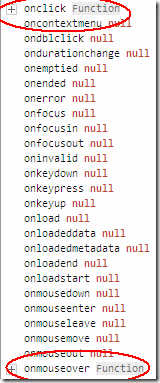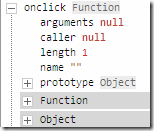 Web Front-end
Web Front-end
 JS Tutorial
JS Tutorial
 Small test of event binding onclick && addEventListener_javascript skills
Small test of event binding onclick && addEventListener_javascript skills
Small test of event binding onclick && addEventListener_javascript skills
There should be corresponding functions in the development tools, so I tested it:
Premise: It is just a simple small test, and addEventListener is a standard binding function, which is not compatible with this in IE (the corresponding IE is attachEvent), so this time For testing, abandon IE first and use Firefox 5.0.1, Chrome 14.0, Opera 11.50
Test page:
页面效果如下截图:

测试代码中采用了三种最常见的事件绑定方法
FIREFOX:
1,Firefox 的 Firebug 中选中 test1 元素:

右侧 DOM 标签中选择显示所有属性:

在其中找到了 attributes 数组,如下:

这是因为 test1 元素的两个事件句柄直接写到了元素中,再往下的列表中找不到更多相关的信息,此种绑定模式下只能在 firebug 的 DOM 标签的 attributes 中找到事件句柄。
2,选中 test2 元素:

右侧 DOM 标签:

test2 采用在 javascript 中绑定事件句柄的方式,被作为“用户自定义属性”显示在了 DOM 标签中,右击鼠标可以查看相关信息:

3,选中 test3 元素:

这次在 DOM 标签中没有找到任何相关此元素绑定事件的信息。。。
总而言之,firebug 中在标准绑定事件函数下(addEventListener),并不好检测到某个元素已绑定的事件函数,(不要说尝试打印一下那个元素的 onclick 属性,addEventListener 绑定和 onclick 绑定毫不相干,此种情况下你会得到 nudefined);如果是在前两种事件绑定下,可以得到一些简单信息。
-----
OPERA:
1,在 Opera 的 Dragonfly 中选中 test1 :

在右方的属性列表中可以找到相关的信息:

点击加号同样可以查看绑定的函数信息:

想查看某个函数体的话,有一种简单的方法,在控制台中直接输入:

直接就打印出函数体,更加的方便!
2,选择 test2 和 test1 几乎相同,就不在赘述了;
3,选择 test3:

Nothing can be found in the attribute tag on the right. The values of onclick and onmouseover are both null.
In short, Opera Dragonfly and Firefox Firebug perform similarly, and it is not very clear which events are bound to an element under the standard binding function.
-----
CHROME:
It’s much clearer in Chrome:
1, select test1 (or test2, these two are similar) in the debugging tool

Look at the information bit on the right:

Event Listeners in Chrome is a good little tool that directly lists the listening functions that have been bound to the currently selected element. Click the small black triangle to view the information of the bound functions:

There are two items in click. The first item is div#test1, which is the onclick function information we bound; the second item, document, does not need to be seen (Chrome’s own processing);
isAttribute: true: Indicates that this onclick function handle is treated as an element attribute (because we use onclick = function(){…}, whether it is test1 or test2);
lineNumber: 18: indicates the location of the bound function;
useCapture: false : Indicates that event capture is not used; other semantics are very strong, so I won’t mention them;
Similarly, in the first HTMLDivElement list of Properties, both test1 and test2 can see:

2, select test3:

In Properties both onclick and onmouseover will become null, but Event Listeners will still be:

But notice the div#test3:

isAttribute becomes false because we do not use the onclick attribute, but use addEventListener.
Remember these first! The writing is a bit messy~

Hot AI Tools

Undresser.AI Undress
AI-powered app for creating realistic nude photos

AI Clothes Remover
Online AI tool for removing clothes from photos.

Undress AI Tool
Undress images for free

Clothoff.io
AI clothes remover

Video Face Swap
Swap faces in any video effortlessly with our completely free AI face swap tool!

Hot Article

Hot Tools

Notepad++7.3.1
Easy-to-use and free code editor

SublimeText3 Chinese version
Chinese version, very easy to use

Zend Studio 13.0.1
Powerful PHP integrated development environment

Dreamweaver CS6
Visual web development tools

SublimeText3 Mac version
God-level code editing software (SublimeText3)

Hot Topics
 1664
1664
 14
14
 1423
1423
 52
52
 1318
1318
 25
25
 1269
1269
 29
29
 1248
1248
 24
24
 JavaScript Engines: Comparing Implementations
Apr 13, 2025 am 12:05 AM
JavaScript Engines: Comparing Implementations
Apr 13, 2025 am 12:05 AM
Different JavaScript engines have different effects when parsing and executing JavaScript code, because the implementation principles and optimization strategies of each engine differ. 1. Lexical analysis: convert source code into lexical unit. 2. Grammar analysis: Generate an abstract syntax tree. 3. Optimization and compilation: Generate machine code through the JIT compiler. 4. Execute: Run the machine code. V8 engine optimizes through instant compilation and hidden class, SpiderMonkey uses a type inference system, resulting in different performance performance on the same code.
 Python vs. JavaScript: The Learning Curve and Ease of Use
Apr 16, 2025 am 12:12 AM
Python vs. JavaScript: The Learning Curve and Ease of Use
Apr 16, 2025 am 12:12 AM
Python is more suitable for beginners, with a smooth learning curve and concise syntax; JavaScript is suitable for front-end development, with a steep learning curve and flexible syntax. 1. Python syntax is intuitive and suitable for data science and back-end development. 2. JavaScript is flexible and widely used in front-end and server-side programming.
 JavaScript: Exploring the Versatility of a Web Language
Apr 11, 2025 am 12:01 AM
JavaScript: Exploring the Versatility of a Web Language
Apr 11, 2025 am 12:01 AM
JavaScript is the core language of modern web development and is widely used for its diversity and flexibility. 1) Front-end development: build dynamic web pages and single-page applications through DOM operations and modern frameworks (such as React, Vue.js, Angular). 2) Server-side development: Node.js uses a non-blocking I/O model to handle high concurrency and real-time applications. 3) Mobile and desktop application development: cross-platform development is realized through ReactNative and Electron to improve development efficiency.
 How to Build a Multi-Tenant SaaS Application with Next.js (Frontend Integration)
Apr 11, 2025 am 08:22 AM
How to Build a Multi-Tenant SaaS Application with Next.js (Frontend Integration)
Apr 11, 2025 am 08:22 AM
This article demonstrates frontend integration with a backend secured by Permit, building a functional EdTech SaaS application using Next.js. The frontend fetches user permissions to control UI visibility and ensures API requests adhere to role-base
 Building a Multi-Tenant SaaS Application with Next.js (Backend Integration)
Apr 11, 2025 am 08:23 AM
Building a Multi-Tenant SaaS Application with Next.js (Backend Integration)
Apr 11, 2025 am 08:23 AM
I built a functional multi-tenant SaaS application (an EdTech app) with your everyday tech tool and you can do the same. First, what’s a multi-tenant SaaS application? Multi-tenant SaaS applications let you serve multiple customers from a sing
 From C/C to JavaScript: How It All Works
Apr 14, 2025 am 12:05 AM
From C/C to JavaScript: How It All Works
Apr 14, 2025 am 12:05 AM
The shift from C/C to JavaScript requires adapting to dynamic typing, garbage collection and asynchronous programming. 1) C/C is a statically typed language that requires manual memory management, while JavaScript is dynamically typed and garbage collection is automatically processed. 2) C/C needs to be compiled into machine code, while JavaScript is an interpreted language. 3) JavaScript introduces concepts such as closures, prototype chains and Promise, which enhances flexibility and asynchronous programming capabilities.
 JavaScript and the Web: Core Functionality and Use Cases
Apr 18, 2025 am 12:19 AM
JavaScript and the Web: Core Functionality and Use Cases
Apr 18, 2025 am 12:19 AM
The main uses of JavaScript in web development include client interaction, form verification and asynchronous communication. 1) Dynamic content update and user interaction through DOM operations; 2) Client verification is carried out before the user submits data to improve the user experience; 3) Refreshless communication with the server is achieved through AJAX technology.
 JavaScript in Action: Real-World Examples and Projects
Apr 19, 2025 am 12:13 AM
JavaScript in Action: Real-World Examples and Projects
Apr 19, 2025 am 12:13 AM
JavaScript's application in the real world includes front-end and back-end development. 1) Display front-end applications by building a TODO list application, involving DOM operations and event processing. 2) Build RESTfulAPI through Node.js and Express to demonstrate back-end applications.



